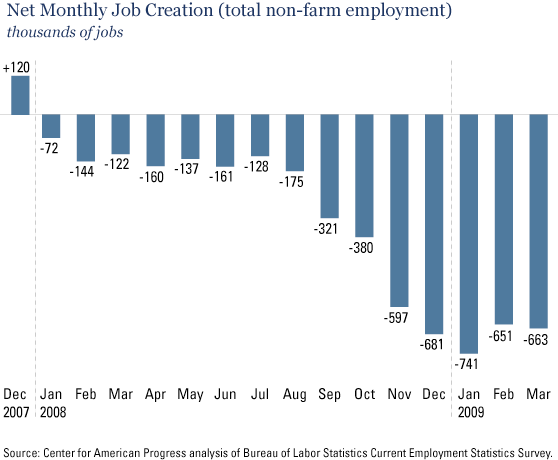|
FEBRUARY 2009 UNEMPLOYMENT DATA*
(U.S.
BUREAU OF LABOR STATISTICS)
OFFICIAL UNEMPLOYMENT:
8.1%
A year earlier, the number of unemployed
persons was 7.4
million, and the jobless rate was 4.8 percent. [BLS]
| White |
7.3% |
| African
American |
13.4% |
| Hispanic |
10.9% |
| Asian** |
6.9% |
| Persons with a disability** |
14.0% |
| Men
20 years and over |
8.1% |
| Women
20 years and over |
6.7% |
| Teen-agers
(16-19 years) |
21.6% |
| Black
teens |
38.8% |
| Officially
unemployed |
12.5
million |
HIDDEN UNEMPLOYMENT
| Working
part-time because can't find a full-time job: |
8.6
million |
| People
who want jobs but are
not looking so are
not counted in official statistics (of which about 2.1 million**
searched for work during the prior 12 months and were available
for work during the reference week.) |
5.6
million |
|
Total:
26.7 million (16.7% of the labor force)
|
Source: http://www.bls.gov/news.release/pdf/empsit.pdf
In addition, millions
more were working full-time, year-round, yet earned
less than the official poverty level for a family of four. In
2007, the latest
year available, that number was 17.6 million, 16.2 percent of
full-time workers (estimated from Current Population Survey, Bur.
of the Census, 2008).
In
January, 2009, the latest month available, the number of job
openings was only 3.0 million, according to the BLS,
Job Openings and
Labor Turnover Estimates, Mar. 10, 2009.+ Thus there
are nearly 9 job-
wanters for each available job.[Numbers are not
comparable with previous months as methods have been revised.]
Mass
layoffs: " Employers
took 2,769 mass layoff actions in February that resulted in the
separation of 295,477 workers, seasonally adjusted, as measured
by new filings for unemployment insurance benefits during the
month, the Bureau of Labor Statistics of the U.S. Department of
Labor reported today. Each action involved at least 50 persons
from a single employer. The number of mass layoff events in February
increased by 542 from the prior month, while the number of associated
initial claims increased by
57,575. Over the year, the number of mass layoff events increased
by 1,100, and the associated initial claims increased by 112,439.
....
This year, both average weekly events and initial claimants reached
their highest
February levels in program history; data are available back to
1996. Thirteen of the 19 major industry sectors reported program
highs in terms of average weekly initial claimants for the month
of February— mining; construction; manufacturing; wholesale
trade; retail trade; transportation and warehousing; finance and
insurance; real estate and rental and leasing; professional and
technical services; management of companies and enterprises; educational
services; accommodation and food services; and other
services, except public administration. ....Of the 4 census regions,
the West registered the highest number of initial claims in February
due to mass layoffs (65,792), followed by the Midwest (64,973),
the South (55,542), and the Northeast (32,131)."
(BLS, Mar.10, 2009)
*See Uncommon
Sense #4 for an explanation of
the unemployment measures.
**Not seasonally adjusted.
+"The job openings rate fell to a
new series low of 2.2 percent in January, continuing a 16-month
downward trend. At 3.0 million in January, monthly openings were
down 1.6 million, or 35 percent, since the starting point of the
downward trend in September 2007.
Over the 12 months ending in January, the job openings rate (not
seasonally adjusted) was essentially unchanged in five industries:
mining and logging; retail trade; information; educational services;
and other services. In the remaining 12 industries, at the total
nonfarm and total private level, and in all four regions, the
job openings rate fell significantly over the year. The job openings
rate rose significantly over the year only in the federal government."
 Source:
http://www.americanprogress.org/issues/2009/03/grim_news.html Source:
http://www.americanprogress.org/issues/2009/03/grim_news.html
The
National Jobs for All Coalition is a project of the Council on
Public and International Affairs. |

